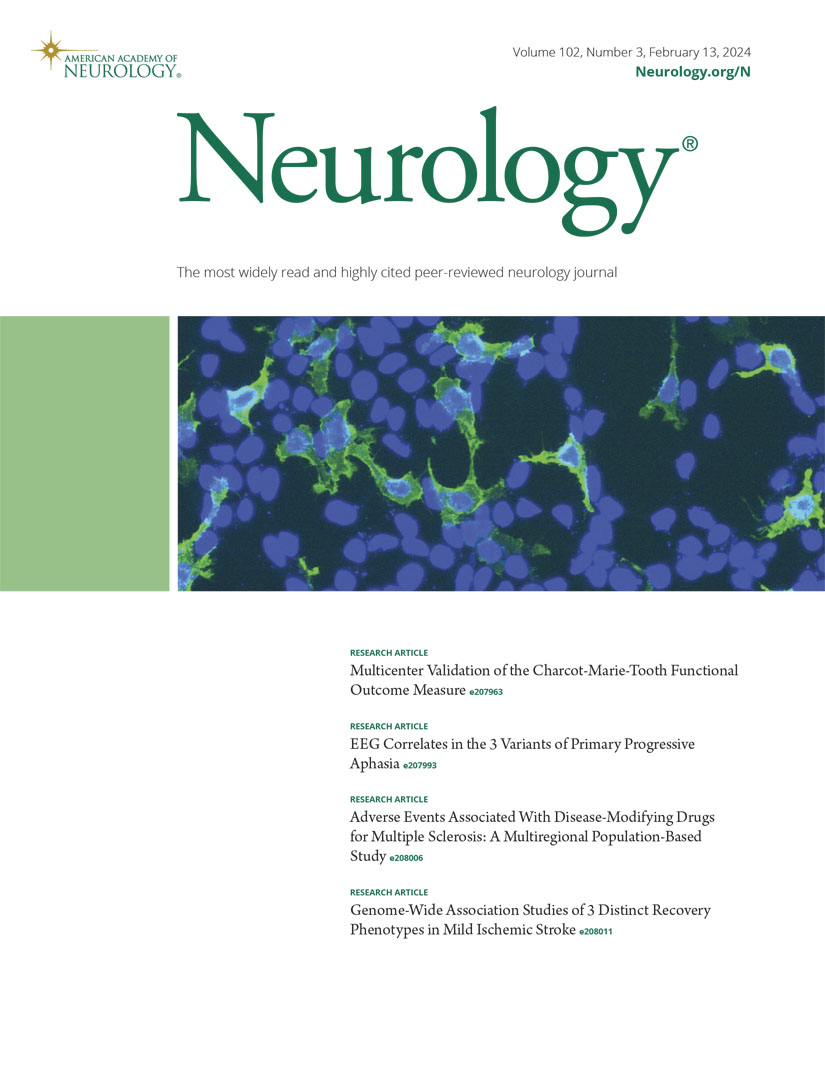拉斯穆森综合征患者皮质萎缩模式与临床表型和组织病理学表现的关联。
IF 7.7
1区 医学
Q1 CLINICAL NEUROLOGY
引用次数: 0
摘要
背景和目的自动MRI分析已经确定了拉斯穆森综合征中皮层萎缩的不同模式。在本研究中,我们旨在确定拉斯穆森综合征的影像学表型,临床表征这些表型,并通过组织病理学分析验证这种基于影像学的方法。方法在这项回顾性病例对照研究中,根据欧洲共识声明和至少一次3D t1加权MRI扫描(发病后<20年)诊断为拉斯穆森综合征的个体在波恩大学医院(1995-2023)确诊。健康对照从波恩大学医院、柏林慈善大学医院和人类连接组项目的数据库中选择。疾病中心,描述与萎缩区域高度连接的大脑区域,使用基于网络的萎缩模型单独绘制。通过k-means聚类鉴定亚型。神经心理学测试结果和神经病理活检分析结果被确定,并使用亚型特异性萎缩图和规范图(通过meta分析[ENIGMA]和神经地图工具箱增强神经成像遗传学)之间的相关性来表征萎缩特征和震中易感性。结果本研究纳入54例拉斯穆森综合征患者(MRI时年龄中位数:18岁,范围2-61岁,女性占65%)和270例健康患者(MRI时年龄中位数:26.5岁,范围3-61岁,女性占49%)。确定了四种不同的萎缩亚型(颞顶叶、中央颞叶、额叶和双侧)。与颞顶(中位11.5年,p = 0.02)和额叶(中位6年,p = 0.02)亚型相比,中位颞叶亚型的发病年龄更小(中位5.5年)。颞顶叶和额叶亚型观察到最严重的神经心理损害。在颞顶叶和额叶亚型中,萎缩优先发生在中枢(r = -0.28, p = 0.006;R = -0.30, p = 0.02)。疾病中心易感性与较高的皮质厚度(r = -0.57, p = 0.005)、较低的髓磷脂含量(r = 0.47, p = 0.02)、较低的脑血流量(r = 0.42, p = 0.03)、较低的血容量(r = 0.57, p = 0.006)和较低的氧代谢(r = 0.47, p = 0.01)相关。脑活检显示强烈炎症来自可能的震中,而炎症较弱的活检来自不太可能的震中(p = 0.04)。讨论使用拉斯穆森综合征作为模型,我们用组织病理学证据验证基于成像的单个疾病中心映射。随着进一步的验证,基于网络的单个疾病中心映射可能用于拉斯穆森综合征,以指导活检部位选择,告知治疗决策,并改善预后。本文章由计算机程序翻译,如有差异,请以英文原文为准。
Association of Cortical Atrophy Patterns With Clinical Phenotypes and Histopathological Findings in Patients With Rasmussen Syndrome.
BACKGROUND AND OBJECTIVES
Automated MRI analyses have identified variable patterns of cortical atrophy in Rasmussen syndrome. In this study, we aim to identify imaging phenotypes of Rasmussen syndrome, to clinically characterize these phenotypes, and to validate this imaging-based approach through histopathologic analysis.
METHODS
For this retrospective case-control study, individuals with Rasmussen syndrome diagnosed according to the European Consensus Statement and at least one 3D T1-weighted MRI scan (<20 years after onset) were identified from the University Hospital Bonn (1995-2023). Healthy controls were selected from databases at the University Hospital Bonn, Charité University Hospital Berlin, and the Human Connectome Project. Disease epicenters, describing brain regions highly connected to atrophy regions, were mapped individually using network-based atrophy modeling. Subtypes were identified through k-means clustering. Neuropsychological test results and results from neuropathologic analyses of biopsies were ascertained, and correlations between subtype-specific atrophy maps and normative maps (enhancing neuro imaging genetics through meta analysis [ENIGMA] and neuromaps toolbox) were used to characterize atrophy profiles and epicenter susceptibility.
RESULTS
The study incorporated 54 individuals with Rasmussen syndrome (median age at MRI: 18 years, range 2-61, 65% female) and 270 healthy individuals (median age at MRI: 26.5 years, range 3-61, 49% female). Four distinct atrophy subtypes were identified (temporoparietal, centrotemporal, frontal, and bilateral). Individuals with the centrotemporal subtype were younger at onset (median 5.5 years) than individuals with temporoparietal (median 11.5 years, p = 0.02) and frontal (median 6 years, p = 0.02) subtypes. Most severe neuropsychological impairment was observed for the temporoparietal and frontal subtypes. In the temporoparietal and frontal subtypes, atrophy occurred preferentially in hubs (r = -0.28, p = 0.006; r = -0.30, p = 0.02). Disease epicenter susceptibility was associated with higher cortical thickness (r = -0.57, p = 0.005), lower myelin content (r = 0.47, p = 0.02), lower cerebral blood flow (r = 0.42, p = 0.03), lower blood volume (r = 0.57, p = 0.006), and lower oxygen metabolism (r = 0.47, p = 0.01). Brain biopsies showing strong inflammation were taken from likely epicenters, whereas biopsies with weaker inflammation came from less likely epicenters (p = 0.04).
DISCUSSION
Using Rasmussen syndrome as a model, we validate imaging-based mapping of individual disease epicenters with histopathologic evidence. With further validation, network-based mapping of individual disease epicenters could potentially be used in Rasmussen syndrome to guide biopsy site selection, inform treatment decisions, and improve outcome prognoses.
求助全文
通过发布文献求助,成功后即可免费获取论文全文。
去求助
来源期刊

Neurology
医学-临床神经学
CiteScore
12.20
自引率
4.00%
发文量
1973
审稿时长
2-3 weeks
期刊介绍:
Neurology, the official journal of the American Academy of Neurology, aspires to be the premier peer-reviewed journal for clinical neurology research. Its mission is to publish exceptional peer-reviewed original research articles, editorials, and reviews to improve patient care, education, clinical research, and professionalism in neurology.
As the leading clinical neurology journal worldwide, Neurology targets physicians specializing in nervous system diseases and conditions. It aims to advance the field by presenting new basic and clinical research that influences neurological practice. The journal is a leading source of cutting-edge, peer-reviewed information for the neurology community worldwide. Editorial content includes Research, Clinical/Scientific Notes, Views, Historical Neurology, NeuroImages, Humanities, Letters, and position papers from the American Academy of Neurology. The online version is considered the definitive version, encompassing all available content.
Neurology is indexed in prestigious databases such as MEDLINE/PubMed, Embase, Scopus, Biological Abstracts®, PsycINFO®, Current Contents®, Web of Science®, CrossRef, and Google Scholar.
 求助内容:
求助内容: 应助结果提醒方式:
应助结果提醒方式:


